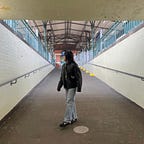Brunswick Design District: Home to local artists and businesses
The development of a creative design district located in Brunswick was made possible through a collaboration among RMIT University, Merri-bek City Council, and the State Government’s Creative Victoria, which resulted in the establishment of the Brunswick Design District (BDD).
Their purpose was to help the design industry and economy by supporting its recovery from the effects of COVID-19, improving local resilience, along with enhancing the design and creative ecosystem in Brunswick. Their approach involve enhancing public spaces, transforming urban areas, improving educational and employment opportunities, creating affordable shared spaces for collaboration and creativity, as well as linking buildings and infrastructure. It is then possible to assume that as local authorities and developers collaborated with major cultural institutions to regenerate vacant land, art emerged as a fresh source of energy for urban growth machines (Whitt, 1987 as cited in Ashley, 2014).
Through its Creative State 2016–2020 initiatives, Creative Victoria sets out a vision for the growth and development of Victoria’s creative industries, including BDD, with a focus on backing creative talents, strengthening the creative industries ecosystem, delivering wider economic and social impact, increasing participation and access, as well as building international engagement. In this context, the government treated art as a resource that boosts consumption, promotes the growth of properties, and improves the reputation of the city (Grodach, 2017).
In addition to that, the RMIT PlaceLab facilitates members of the Brunswick community and RMIT research team to exchange ideas, which will inform research-driven solutions to enhance the local urban environment through community-based initiatives. This is important because creative placemaking should give serious consideration to the difficulties involved in getting the community involved and should create projects that take into account power imbalances, while also utilising local participation and resources (Ferili, Sacco, & Blessi, 2016). Specific project themes are identified through PlaceLab’s engagement activities with potential areas of focus include job creation, student opportunities, urban renewal, and sustainability.
Equally important, entrepreneurs in the area can connect, collaborate, and share new concepts at Brunswick Design and Innovation (BRUDI), a bustling centre for economic growth, which is a significant component of the Brunswick Design District. Another plan was to offer tenants and local start-ups various commercialisation paths to foster their businesses and expansion. These include business development and educational programs, as well as events to attract investors and capital to the area, with the goal of creating jobs for the local community by turning ideas into reality. This project is in line with the view that making use of local culture and artistic expression as a model for innovation — and turn those who create art outside of mainstream culture into entrepreneurs — make art and culture valuable resources for economic development (Yudice, 2003).
In conclusion, BDD is a positive step towards the development of the design industry and economy. The collaboration between various institutions has provided a platform for the enhancement of the creative ecosystem in Brunswick. The inclusion of the RMIT PlaceLab and BRUDI is also particularly impressive as they offer unique opportunities for community-based initiatives and the commercialisation of local start-ups, respectively.
